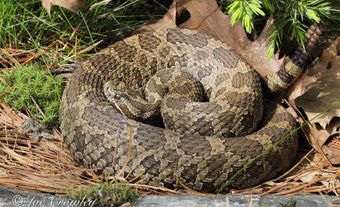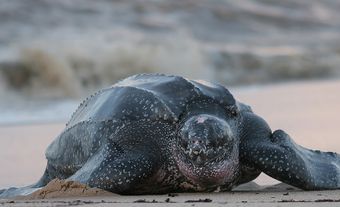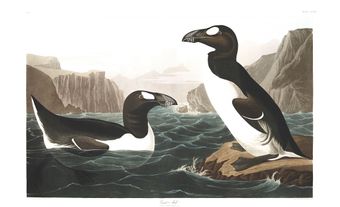The Blanding’s turtle (Emydoidea blandingii) is a medium-sized, freshwater turtle that is native to northeastern North America. In Canada, Blanding’s turtles are found throughout southern and central Ontario, in extreme southwestern Quebec, and in southern Nova Scotia. Blanding’s turtles are endangered throughout their range. The primary threats to the species in Canada include widespread mortality on roads and ongoing loss of wetland habitat.

Description
The Blanding’s turtle is a medium-sized, freshwater turtle with an elongate, highly domed, smooth upper shell (also known as a “carapace”). Females have a maximum carapace length of just over 24 cm, while males can reach a maximum carapace length of just over 28 cm. The carapace, head, legs and tail are black, brown or bluish-grey with varying amounts of yellow or tan flecking or mottling. Their chin and throat are a vibrant yellow. The bottom shell (also known as a “plastron”) is yellow with large dark blotches. The plastron has a movable central hinge that allows the front and back lobes to be pulled upward to close with the carapace. Like many aquatic turtles, Blanding’s turtles’ feet are webbed, which helps them swim.
Distribution and Habitat

In Canada, Blanding’s turtles are found throughout southern and central Ontario, in southwestern Quebec and in a small, disjunct pocket in southern Nova Scotia. In Ontario, Blanding’s turtles are found as far north as Cochrane, a town in northeastern Ontario, and Jellicoe, a town north of Lake Superior. However, the species’ distribution becomes very patchy in the northern extent of its range. In the United States, the Blanding’s turtle’s range extends from northern Missouri, Nebraska, and eastern South Dakota and Minnesota eastward to southern Maine, New Hampshire and Massachusetts.

Blanding’s turtles are typically found in shallow-water habitats with soft bottoms and lots of aquatic vegetation. These habitats include marshes, swamps, ponds, slow-flowing creeks and shallow bays of lakes. Individuals typically use multiple wetlands throughout the year. Blanding’s turtles make their nests relatively close to water and in sunny areas. Here, warm temperatures help the eggs develop. They will travel considerable distances through forests, fields and other terrestrial habitats when migrating between wetlands or to nesting sites. They have large home ranges that often span distances of over 1 km. Blanding’s turtles spend the winter months in small, shallow wetlands below the ice.
Did you know?
Turtles have lungs and breathe air, yet they are able to spend several months submerged under the ice during the winter. Under the ice, a turtle’s body temperature is the same as the frigid water — close to 0°C. At these low temperatures, their metabolism slows considerably and they require very little oxygen. So little, in fact, that they are able to get all the oxygen they need by absorbing it through the lining of their mouth and cloaca (the opening under their tail used for mating and excreting waste).
Reproduction and Development
Blanding’s turtles mate throughout the spring, summer and fall, but mating is most common in the spring and early summer. Females produce a clutch of eggs every 1–3 years. Clutch size ranges from 1 to 25 eggs, with an average of 6–13 eggs. In Canada, nesting occurs from late May to early July. Hatchlings emerge from the eggs from early August to late October. Like many freshwater turtles, Blanding’s turtles have temperature-dependent sex determination, meaning the sex of the offspring is determined by the incubation temperature of the eggs. Cooler temperatures produce males while warmer temperatures produce females.
Blanding’s turtles do not reach sexual maturity until they are 14–26 years of age, with individuals in Canadian populations being at the upper end of this range. Freshwater turtle eggs, hatchlings and young juveniles have very low survival rates; less than 1 per cent of Blanding’s turtle eggs will produce turtles that survive to adulthood. Once individuals reach adult sizes, however, they can live to be over 80 years of age. These long lifespans are necessary to make up for the very slow addition of new turtles to the breeding population.

Diet and Predation
Blanding’s turtles are primarily carnivorous and forage for a variety of small animals, including worms, snails, slugs, leeches, crustaceans, insects, small fish, fish eggs, amphibians, amphibian larvae and carrion (dead animals). They also consume plants in small amounts. They typically capture and swallow their prey by sucking water into their mouths. Because of this, Blanding’s turtles usually forage in aquatic habitats.
A variety of mammals prey on Blanding’s turtles and their nests, including raccoons, foxes and skunks. Predation of adult Blanding’s turtles is rare because their shell provides excellent defence against predators. Nests and hatchlings, on the other hand, experience high rates of predation. Hatchlings are consumed by a wide range of predators that also include small mammals (e.g., squirrels, chipmunks, shrews), large birds, fish and snakes.
Threats
Because of their long lifespans, delayed maturity and low nest and hatchling survival, the death of even a small number of adult Blanding’s turtles can cause population declines. This makes roads a serious threat to Blanding’s turtles, and road mortality is a major cause of the ongoing decline of this species in Canada. Ongoing habitat loss and fragmentation, particularly wetland destruction, is also a serious threat to this species. Populations of some predators, such as raccoons, have become over-abundant in many human-settled areas due to increased food sources (e.g., garbage, corn fields). In some areas, these “subsidized” predators can result in the destruction of almost all nests. Illegal collection of Blanding’s turtles for the pet trade or for food also poses a threat to this species in Canada.
Status and Conservation
Globally, the Blanding’s turtle is listed as endangered by the International Union for Conservation of Nature. Both Canadian populations (Great Lakes/St. Lawrence and Nova Scotia) are also listed as endangered under the Canadian Species at Risk Act. Although endangered species legislation provides legal protection to Blanding’s turtles and their habitats in Canada, the dense network of existing roads continues to pose a serious threat. The successful recovery of Blanding’s turtles –– and most of Canada’s at-risk turtle species –– requires a collaborative effort among governments, non-government organizations and the public, specifically to address turtle road mortality.

 Share on Facebook
Share on Facebook Share on X
Share on X Share by Email
Share by Email Share on Google Classroom
Share on Google Classroom



